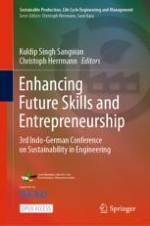26.1 Introduction
26.2 Literature Review
26.3 Methodology
-
Motivation to work in teams
-
Attending team sessions and
-
Delivering Presentation
-
Handling questions and answers.
26.3.1 Professional Presentations
26.3.2 Group Discussion
26.3.3 Interviews
-
Personality
-
Knowledge
-
Communication skills
-
Leadership skills
-
Problem solving skills
-
Decision making skills.
